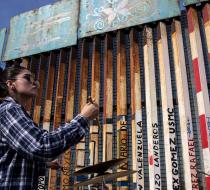John Luther Adams: Inuksuit - A Border-Crossing Presentation Favorite
The San Diego Symphony performs John Luther Adams piece "Inuksuit" at the U.S.-Mexico border.
Premiered in the Canadian Rockies, John Luther Adams’s outdoor masterpiece, Inuksuit, is a mirror of the landscape in which it is performed. We’ll play the piece at International Friendship Park (Monument Rd., San Diego, CA 92154) on the US/Mexico border at 12:30pm on January 27. We hope to reveal not just the sonic landscape of the border, but also qualities of its cultural and social topography. A bi-national group of Mexican and American percussionists, each performing on its own side of the border wall, will use the international language of sound to reflect a landscape of beautiful sounds, fascinating cultures and close neighbors. Based on the stone sentinels built by Inuit people of the circumpolar Arctic, Inuksuit reminds us that the climate is changing, the ice retreating and the seas rising.
The binational event brought close to 70 players to both sides of the border wall at Friendship Park to play “Inuksuit,” a piece for percussion instruments by the American composer John Luther Adams.
The composition, which premiered in the Canadian Rockies, is meant to be played out of doors. The setting this time was the northern edge of Border Field State Park, amid concrete picnic tables, views of the Pacific Ocean and vigilant U.S. Border Patrol vehicles.
The free hour-long concert was part of the San Diego Symphony’s third annual festival called “It’s About Time: A Festival of Rhythm. Sound. And Place.” The festival’s curator is Steven Schick, a percussionist and professor at University of California San Diego.
“This piece demonstrates that music is alive on the outside of the hall as it is on the inside,” said Schick. “It is designed to mold itself around the qualities of a place, and not the other way around.”
He steered clear of making any connection between the concert’s setting and the attention brought to the U.S.-Mexico border by President Donald Trump’s call for a continuous wall.
“Given the advent of Trump and the tensions surrounding the wall, the Border Patrol rejected a lot of proposals. A German orchestra wanted to do a protest concert, and were turned down. But we convinced them that this wasn’t a purely political gesture. I’d thought of this long before Trump became an issue. The work was a wedding present for me and my wife, Brenda. It’s very personal for me, and I wanted it to be heard first as music, not as a statement.”
That said, politics was on everyone’s mind, and provoked media interest. Al Jazeera sent a film crew to document any signs of resistance. Schick has not been timid on the subject of Trump: on Inauguration Day, he made a statement in conjunction with a concert he was conducting in San Francisco. He declined, however, to describe the “Inuksuit” event as a protest. He told me, “One could be forgiven for having all kinds of political thoughts. But I’m mindful of the fact that Border Patrol went out of their way to make this happen. After the rain, they opened their own roads to us so our musicians could get their instruments to the fence.”
“We’re making a concert, it’s not a protest,” said Schick. “The place we live in is fascinatingly positioned on the international border. We thought, what if we took this piece, what qualities of that place would we hear?”
To perform the piece, musicians brought a wide range of instruments: bass drums, bongo and conga drums, cymbals, triangles, crotales, maracas, conch shells, even an air-raid siren.
The sounds started softly, with musicians blowing through funnels. It built up with whistling, and rattling sounds, rising to a heart-pounding crescendo of drumbeats, cymbals and sirens. It ended with delicate notes of piccolo and glockenspiel, emulating bird sounds — and finally with a moment of silence.
The performers included members of the San Diego Symphony, as well as students from UCSD, San Diego State University, Chapman University and the California Institute of the Arts. “Going into it, I wasn’t sure how things would work out,” said Skye Landers, a 19-year-old music education student from SDSU. “It was a lot of fun, everything blended the way we hoped it would.”
South of the border, musicians came from Tijuana, Ensenada, Guanajuato and Mexico City, said Jorge Peña, percussionist with the Baja California Orchestra and one of the organizers on the Mexican side.
“This is incredible, marvelous, historic,” said Peña, speaking through the fine-mesh fence. “We can’t physically cross, but the music is penetrating both sides, and that’s what’s important.”
Applause rose on both sides as the piece ended, and Schick spoke up to thank the Tijuana musicians. “I will never forget this as long as I live,” he said.
With the access road on the U.S. side washed out, both musicians and some 200 members of the public faced a half-hour walk to reach the venue at the northern end of Border Field State Park.
Among the audience members were friends JoAnna George, a middle-school Spanish teacher in Vista, and Rachell Tabor, who teaches theater to elementary school students in Chula Vista.
Both were pleased. “You bring the two countries together for something so beautiful,” said George.
“It blew me away,” added Tabor, “what an amazing, unifying thing.”







